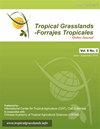哥伦比亚热带干旱气候下大菱鲆种群的营养和生物量评估
IF 0.7
4区 农林科学
Q3 AGRICULTURE, DAIRY & ANIMAL SCIENCE
引用次数: 0
摘要
对在哥伦比亚雨季建立的28份大麦穗麦材料的农艺和营养参数进行了评估,以确定营养质量存在差异的材料,并对大麦穗麦穗麦种质进行了表征。方差分析和多变量分析显示材料之间存在差异。株高、干物质产量和绿色鲜重等农艺变量与营养变量无关。开花影响营养品质(中性洗涤剂纤维、酸性洗涤剂纤维和相对饲料价值)。花期、纤维含量、消化率和粗蛋白含量对大菱鲆饲料品质的影响最大。生物量和营养参数的综合评价表明,28份大白菜材料中含有2份营养品质高、生物量产量有竞争力的材料。营养和农艺评估中收集的异质性支持植物育种,并为热带地区的牛生产者提供了替代品。本文章由计算机程序翻译,如有差异,请以英文原文为准。
Nutritional and biomass evaluation of a Megathyrsus maximus collection in a dry tropical climate in Colombia
Agronomic and nutritional parameters of a set of 28 accessions of Megathyrsus maximus established in Colombia during the rainy season were evaluated to identify accessions with differences in nutritional quality and characterize germplasm of M. maximus. ANOVA and multivariate analysis showed differences among accessions. Agronomic variables such as plant height, dry matter yield and green fresh weight were not correlated with nutritional variables. Flowering affected nutritional quality (neutral detergent fiber, acid detergent fiber and relative feed value). Flowering, fiber content, digestibility and crude protein content had the most influence on forage quality of M. maximus. The integral evaluation of biomass and nutritional parameters showed that the set of 28 M. maximus accessions contained 2 accessions with high nutritional quality and competitive biomass production. Heterogeneity of the collection in nutritional and agronomic assessments supports plant-breeding and offers alternatives for cattle producers in the tropics.
求助全文
通过发布文献求助,成功后即可免费获取论文全文。
去求助
来源期刊

Tropical Grasslands-Forrajes Tropicales
Agricultural and Biological Sciences-Agronomy and Crop Science
CiteScore
1.60
自引率
0.00%
发文量
36
审稿时长
16 weeks
期刊介绍:
The Journal publishes, in English or Spanish, Research Papers and Short Communications on research and development, as well as contributions from practitioners (Farmer Contributions) and Review Articles, related to pastures and forages in the tropics and subtropics. There is no regional focus; the information published should be of interest to a wide readership, encomprising researchers, academics, students, technicians, development workers and farmers.
In general, the focus of the Journal is more on sown (''improved'') pastures and forages than on rangeland-specific aspects of natural grasslands, but exceptions are possible (e.g. when a submission is relevant for a particularly broad readership in the pasture and forage science community).
The Journal will also consider the occasional publication of associated, but closely related, research in the form of an additional scientific communication platform [e.g. a re-make of the former Genetic Resources Communication series of the former Division of Tropical Crops and Pastures of the Commonwealth Scientific and Industrial Research Organisation (CSIRO), Australia].
Areas of particular interest to the Journal are:
Forage Genetic Resources and Livestock Production[...]
Environmental Functions of Forages[...]
Socio-economic Aspects[...]
Topics within the aforementioned areas may include: Diversity evaluation; Agronomy; Establishment (including fertilization); Management and utilization; Animal production; Nutritive value; Biotic stresses (pests and diseases, weeds); Abiotic stresses (soil fertility, water, temperature); Genetics and breeding; Biogeography and germplasm collections; Seed production; Ecology; Physiology; Rhizobiology (including BNF, BNI, mycorrhizae); Forage conservation; Economics; Multilocational experimentation; Modelling.
 求助内容:
求助内容: 应助结果提醒方式:
应助结果提醒方式:


